A collection of videos relating to the diagnosis and treatment of eye movement disorders. This collection includes many demonstrations of examination techniques.
Dan Gold, D.O., Associate Professor of Neurology, Ophthalmology, Neurosurgery, Otolaryngology - Head & Neck Surgery, Emergency Medicine, and Medicine, The Johns Hopkins School of Medicine.
A collection of videos relating to the diagnosis and treatment of eye movement disorders.
NOVEL: https://novel.utah.edu/
TO
1 - 25 of 9
| Title | Description | Subject | ||
|---|---|---|---|---|
| 1 |
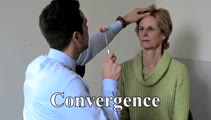 |
Convergence | Can bring out or change the direction of vertical nystagmus in Wernicke's, or cerebellar disease; may be impaired in Parkinson's disease, head trauma, elderly patients; may overcome an adduction deficit with an INO. Instructional ocular motor examination procedures. | Convergence; Exam; Abnormal Saccades |
| 2 |
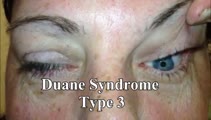 |
Duane's Syndrome Type III | This is a 40-yo-woman seen in neurology clinic for a complaint unrelated to her eyes. On exam, there was impaired adduction and abduction OS. In adduction, there was narrowing of the palpebral fissure OS, a result of her globe retraction due to co-contraction of the medial and lateral rectus muscles... | Duane's Syndrome; Type 3 |
| 3 |
 |
Head-Shaking Nystagmus | Head-shaking nystagmus: With a peripheral lesion, similar to vibration, transiently accentuates vestibular asymmetry when baseline VOR function is asymmetric, central patterns are well described and have localizing value (e.g., causing vertical nystagmus after horizontal head-shaking, horizontal nys... | Nystagmus; Head-shaking Nystagmus; Exam |
| 4 |
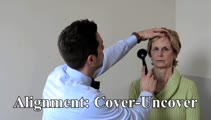 |
Ocular Alignment | 𝗢𝗿𝗶𝗴𝗶𝗻𝗮𝗹 𝗗𝗲𝘀𝗰𝗿𝗶𝗽𝘁𝗶𝗼𝗻: These tests allow for detection of eso-, exo- or hyperdeviations (phorias (one eye viewing) or tropias (both eyes viewing) that can be seen with ocular motor palsy, skew deviation, or with cerebellar disease (commonly eso... | Alignment; Exam |
| 5 |
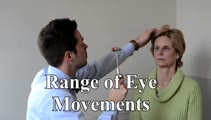 |
Range of Eye Movements and Evaluation for Nystagmus | 𝗢𝗿𝗶𝗴𝗶𝗻𝗮𝗹 𝗗𝗲𝘀𝗰𝗿𝗶𝗽𝘁𝗶𝗼𝗻: Range: Assesses for motility deficit due to an ocular motor palsy, particularly if a posterior fossa localization is being considered; Nystagmus: Spontaneous nystagmus may or may not be noted and gaze-evoked nystagmus is ... | Exam; Nystagmus; Range of Eye Movements |
| 6 |
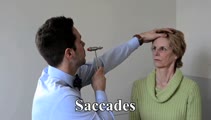 |
Saccades | 𝗢𝗿𝗶𝗴𝗶𝗻𝗮𝗹 𝗗𝗲𝘀𝗰𝗿𝗶𝗽𝘁𝗶𝗼𝗻: The examiner should note: conjugacy (a lag of the adducting eye may be seen with an INO); accuracy (posterior fossa lesions commonly produce dysmetria (overshooting or undershooting); velocity (if slow, may suggest a lesi... | Saccades; Exam; Conjugacy; Abnormal Saccades |
| 7 |
 |
Smooth Pursuit | 𝗢𝗿𝗶𝗴𝗶𝗻𝗮𝗹 𝗗𝗲𝘀𝗰𝗿𝗶𝗽𝘁𝗶𝗼𝗻: A pursuit deficit in one direction suggests an ipsilesional localization, but beware of a superimposed spontaneous nystagmus; a pursuit deficit in all directions is commonly seen with cerebellar lesions. 𝗡𝗲𝘂𝗿�... | Pursuit; Exam |
| 8 |
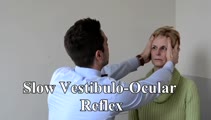 |
VOR (Slow and Fast) | 𝗢𝗿𝗶𝗴𝗶𝗻𝗮𝗹 𝗗𝗲𝘀𝗰𝗿𝗶𝗽𝘁𝗶𝗼𝗻: Slow vestibulo-ocular reflex (VOR): Since smooth pursuit and VOR systems are both active, if eye movements are choppy with this maneuver this implies deficits in both pursuit and the vestibular system as in CANVAS; Fast (... | Vestibulo-ocular Reflex (VOR); Exam |
| 9 |
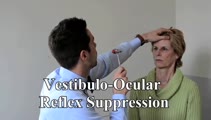 |
VOR (Suppression) | 𝗢𝗿𝗶𝗴𝗶𝗻𝗮𝗹 𝗗𝗲𝘀𝗰𝗿𝗶𝗽𝘁𝗶𝗼𝗻: Deficits in pursuit and vestibulo-ocular reflex (VOR)S usually go together, except when the VOR is absent or markedly diminished in which case there is no VOR to suppress, so that VORS seems better than pursuit. This is a... | Vestibulo-ocular Reflex (VOR) Supression; Exam |
1 - 25 of 9
